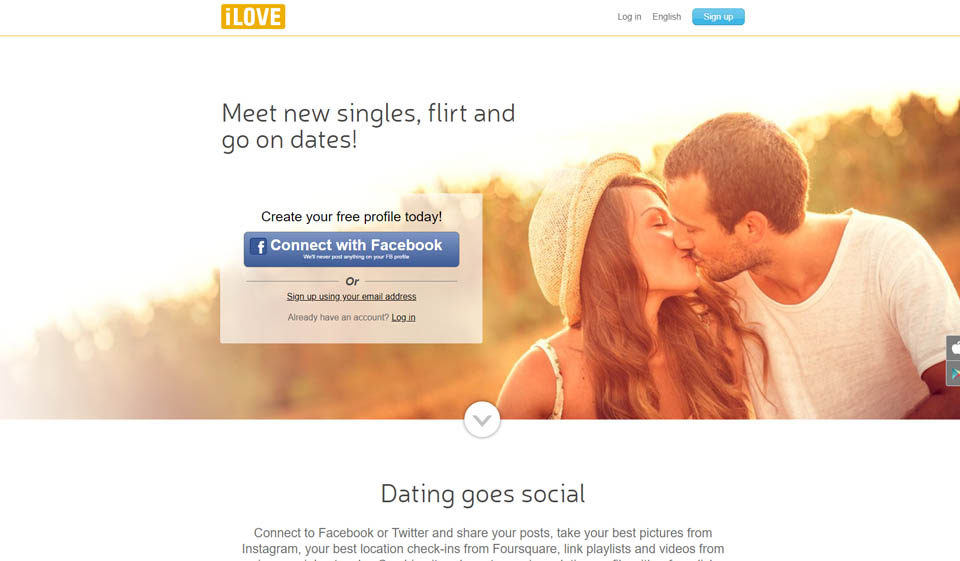iLove review – what do we know about it?

| Active Audience | 94% |
| Quality Matches | 90% |
| Popular Age | 25-30 |
| Profiles | 2 000 000 |
| Reply Rate | 85% |
| Ease of Use | 9.2 |
| Popularity | 9.0 |
| Fraud | Very Rarely |
| Rating |
8.9
|
| Registration | Free |
-
Lilly Melanie
-
22 Jun 2020Updated:12 Jun 2024
-
3985 Views
-
9 min read
Pros and Cons
- iLove makes it easy for users to delete their profile when they need to
- The platform conveniently includes older users.
- It has some affiliate programs.
- The customer support is extensive.
- iLove generally upholds ethical practices on the platform.
- The pricing of iLove is credit-based and might cost more than a subscription-based one.
- The features available are basic and don’t precisely match up with other similar dating sites.
- The Facebook sign-up on iLove website doesn’t work.
- The website has difficulty recognizing zip codes from specific locations.
iLove is a dating website that regards itself as being powered by passions. It is up against a lot of other similar introvert dating sites. Still, it tries to differentiate itself with the principle that successful relationships should stand upon.
It utilizes methods and criteria that are peculiar with sites seeking to bring to individuals together based on love. In addition to that, it cuts back on nerdy calculations such as bust size and favorite food in its matching process.
It adds the actual “chemistry,” which makes two people click on the first match, and iLove thinks it’s one of the most underestimated factors in the online dating space.
Overall, it has made them somewhat distinctive, or at least at the forefront of what a modern dating website should be.
The site was started in June 2003 in Berlin, Germany. It was a subsidiary of the company Jamba AG and intended for German, Swiss and Austrian users. It grew in the user base and was able to attain the peak of the German dating website market in just one and a half years (December 2004). The site had reached around 2.3 million users, and there was an imperative need for expansion.
iLove started expanding its operations to Poland and Russia in 2005, and then the UK the following year. It eventually went international in 2012 and has remained so to this day.

How does iLove work?
Users of iLove would find their experiences not too different from what obtains on other dating sites. They can create a dating profile and have it linked up with their selected social media dating accounts. That way, some of their contents get imported.
Gradually, they can build content based on their interests and preferences (this is referred to as “Passions” on the site). These Passions can then be shared with other users and is an excellent way to start interacting with them.
As far as interaction is concerned, it is quite polished on iLove. It has a chat feature for when you would like to continue the conversation with an interesting person. You do not need a subscription for chatting, which is different from other dating platforms that have some features behind a paywall.
It means you can begin to chat as soon as you register as a new user. The other nifty thing about the chat feature is that it is available on the website version as well as the app. Conversations had on the app version can be continued on the desktop version and vice versa. This is also something not many dating sites offer.
A user can also see other users within their neighborhood, thanks to the location-based search function of the dating platform. It encourages the users of the service to meet in person and carry on whatever conversation they have offline.
Registration – is it really easy?
The process of registering on iLove is straightforward, and one can complete it in small steps. Once a new user tap on the “sign up” button, it would prompt you to choose between registering with Facebook or Email.
The Facebook option requires fewer steps as it just requires you to grant access to your Facebook account. Then, you are already a member of the dating platform.
The email option is also easy, and you only need to create a password and verify the email address you provide.
iLove states that it wouldn’t post anything on your Facebook profile if you give them access to it. It is a considerable effort to assure the users that their data is safe on the platform.

What about design and usability?
iLove has a beautiful website that is very intuitive in user experience. There are no distracting elements, and the present details are attractive and promptly call to action.
Typography is kept minimal without too many words. The texts are scattered with images to maintain a visual balance. The images themselves “pop” and are very dynamic.
Color usage is also kept on the minimum, with just enough to make the brand’s accents and not much else.
iLove kept the actual elements easy to reach for the users for interaction. Overall, the website is optimized for desktop and mobile devices, making it very useful for users.
The mobile application of the site carries the majority of its useful features. It is perfectly suitable for users who might have an issue with accessing a browser for the dating platform. It is also optimized for smaller screen sizes of some smartphones.
Let’s talk about profile quality
Once you have registered on the site, you get a profile. This profile will be your identity on the website afterward.
You will need to fill in some fields in your profile. Thankfully, that won’t be much, since data from your Facebook profile will port over.
The apparent reason you decided to join a dating platform is to interact with other members and to stand a better chance. You will have to make your profile as comprehensive as you can.
There is the option to curate pictures in a gallery, and the gallery can be shared with other users afterward. You can also call images from your social media if you’ve had them connected with your profile.
You can use the chat function to find other users’ profiles from anywhere. When you set up a chat session with them, you can instantly send and receive messages from any device you might be using.
The notification system of the profiles is also innovative, especially when compared with other dating sites. You get notifications when other users check out your profile, and when they send you a message. The user can activate or deactivate this feature based on preference.
Overall, the profile quality of iLove is simplistic and functional. There are no fancy features like the swipe-right-to-accept, and so on. But it does the job when all you’re looking for is a dating profile that is an extension of your other social media profiles.

The mobile application
The app for iLove works very well. That’s because the app has been in development right around the time the site itself was breaking into the global dating scene.
iLove started developing its app from 2006. Then, the Java operating system was still the dominant mobile OS available on mobile devices. Subsequently, iLove launched the iOS version of the app in 2011, and it brought with it the location-based features, for which the platform later became known.
The Android version of the app was launched in 2012, thereby completing the Mobile app portfolio of the dating site.
In their usage, the mobile app versions of iLove offer 100% of all its features, with some added convenience that makes them very intuitive from the user standpoint.
As expected, all the location-based features can only be used on the app as it requires location mapping hardware of the mobile devices.
The apps are lean with candid photo sharing and messaging features. It can also be their pain points in some cases. The app also allows you to see other users’ profiles displayed on a home feed. Tapping on each profile shows additional details and the option to send gifts.
They are not as rich in features as other dating sites, which makes them less fun to use over time. There is no “swipe to match” (although you can swipe through profiles), no chat forum, and the likes.
However, the app versions of iLove are a convenient extension of their leading site, which matters a lot to the user. That’s because no one wants to open up a browser to access iLove services.

Safety & security
When bordering on the issue of security on dating platforms, one has to see it from two perspectives: the safety of users from illegal activities, and the protection of their data from breaches and compromise.
The primary security issue plaguing dating platforms is the presence of elements that are out to deceive and con users. These elements exist as fake profiles and can trick legitimate users out of their money when they have the chance.
The responsibility is upon the sites to not give them that chance and try as much as possible. By upgrading verification processes and other moderation features, they have a better advantage over the “bad guys.”
iLove’s security is pretty basic and doesn’t discourage fake profiles. You should expect to see bogus profiles occasionally, so do not trust anyone easily. Just as it took only two steps for you to become a member of the platform, it takes just little for any other scummy personality.
The other security risk is the data users share on dating platforms, and just like the first one, dating sites are hard at work, ensuring that users feel safe sharing their info.
One way they have been able to secure user data is by beefing up the registration process. Typically, they make users verify every single piece of information they provide while registering, and would also carry out another verification on their end.
Again, iLove misses out on all of that and simply sticks with the simple email verification and Facebook login.
It means that their users’ profiles are just as vulnerable as their corresponding Facebook account, and that is not very safe.
There a lot of scummy profiles since there are no ways to verify their identities during and after registration properly.
The recommendation is that you should only give iLove data and information that you’re comfortable putting on Facebook. If you don’t believe your data is secure on Facebook, then the belief easily carries over to your iLove profile.

Pricing and benefits
Most of the services of the iLove are free and don’t cost anything upfront.
Instant Messaging, which is perhaps the most crucial part of any dating platform, is available on iLove for free, although users can only send three messages every day for free.
However, there are in-app purchases because most of the other features are credit-based.
It means that with credits, you can do things like sending more messages in a day, use the Private Mode, or send gifts to users. Below are the costs of credits:
- 300 credits cost $3.10
- 750 credits (popular) cost $5.17
- 4000 credits cost $20.74
- Unlimited flirting power credit is available based on request
As a user, you would enjoy sending and receiving messages and pictures on iLove, but the credit system means you have to spend more than an actual subscription.
If you don’t like the idea of registering on a dating site that feels like just another social network, you can simply move on. Furthermore, if you don’t want to keep spending on credits, you might be better off checking out other dating platforms.

Help & support
For a simple dating site, iLove does have defined customer support for users, so they can ask for help when the need arises.
It places the helpline link at a very accessible location in the About section of the website, and it does more than just solve a few issues.
It gives users the chance to try out some services, and fix problems that might arise as they use the dating platform over time. Also, there is a helpline link for the Press. That is not a feature you see on many dating sites, for better or worse.
If you’re planning to have an account on iLove for review or research (they regard such people as journalists), you can send an application on their helplines – [email protected] or http://blog.ilove.com/help/. That provides you the chance to get more facts about the platform’s services and make other specific requests you have about iLove in general.
You will have to create a profile first, and then you will need to send your username and the email address you use during the register process, to [email protected], and attach the subject of research.
You also need to send a copy of your ID to show you’re a member of the Press. Once it receives your email, you get access to all of iLove’s services. However, note that it might take some time to get your requests processed because they receive a lot of them. That is usual and expected.
In general, it might not be a common thing to have dating sites make their full services available on-demand to reviewers, but they might have their peculiar reasons.
Focus is placed on the apps, as most of the features can be there without having to jump through hoops.
The app is much better than the website, and iLove laid out the functions to everyone.

Q & A:
Unfortunately, there are not many third party reviews from users who have used the dating site, and there are a lot of fundamental questions potential users often ask. The following are some of the most common questions and their corresponding answers about iLove:
Is iLove safe?
One cannot classify iLove as being “very safe,” but if you don’t mind how Facebook manages your data, then iLove would be fine for you as well
Is iLove a real dating site?
Technically, yes. Users on the site can meet, interact, and even flirt based on the location.
How to use iLove ?
You use the search function to search through other users’ profiles, then send a message to them, or like whatever pictures they have in their gallery.
Is iLove free?
Basically, you can create a free account and get started on the basic features, but there are in-app purchases you would need to make. To use their unique features, you’d have to buy some credits.
Is iLove really works?
Yes, for people who want a simple yet functional dating site, it certainly works.

Conclusion
iLove is trying to be the dating site that allows individuals to flirt and fall in love with an unhindered “chemistry.” But based on its shortcomings, it only happens to be just another dating site.
But that isn’t a bad thing entirely. It’s got apps on the two major platforms that work very well and spares the user of phony features they might not need in a dating app.
Overall, one can recommend iLove for people who would love to flirt and chat with new people without necessarily having to give away too much information.



















































Recommended websites
Most Popular Pages on a Website
- Dating Apps
- Russian Dating
- Gay Dating
- Lesbian Dating
- Trans Dating
- Adult Dating
- Gamer Dating
- Sex Sites
- Interracial Dating
- Christian Dating
- Casual Dating
- BBW Dating
- Cougar Dating
- Lesbian Dating
- Senior Dating
- Collarspace
- Mingle2
- Chatiw
- ChatAvenue
- Flingster
- BlackPeopleMeet
- Secret Benefits
- SilverSingles
- SPDATE
- AfroRomance
- Wireclub
- SugarDaddyMeet
- Chat Zozo
- Chatango
Advertiser Disclosure
The datingmeter site contains reliable information about various online dating products/services. The shared data doesn't constitute legal advice or prediction. We discourage our clients from treating it as such. Note that certain materials may get sponsored.
This content was last updated on February 12th, 2024.










